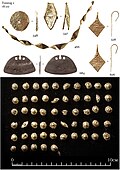 Global Information
Global InformationKokel culture information
51°27′29″N 91°06′12″E / 51.458104°N 91.103251°E
 Kokel 300 Xianbei Tashtyk Kokel Khotan Gaoju Turks CHAM- PA Sargat HYMYAR JIN DYNASTY GOGU- RYEO WESTERN SATRAPS VAKA- TAKAS KUSHANO- SASANIANS LITTLE KUSHANS XIONITES KANGJU SASANIAN EMPIRE ROMAN EMPIRE HUNS FUNAN Jushi TOCHARIANS TUYUHUN Paleo-Siberians Samoyeds Tungus MEROË AKSUM class=notpageimage| The Kokel Culture and contemporary cultures and polities circa 300 CE | |
| Geographical range | South Siberia |
|---|---|
| Dates | 2nd to 5th century CE |
| Major sites | Tunnug, Shurmak, Syyn-Churek, Katylyg |
| Preceded by | Aldy-Bel culture, Pazyryk culture, Tagar culture, Xiongnu Empire |
| Followed by | First Turkic Khaganate |
The Kokel Culture (1st-5th centuries CE) is a post-Xiongnu culture, from Southern Siberia, in the area of the modern Tuva Republic.[1] This culture is located temporally in the interval between the fall of the Xiongnu Empire (2nd century CE) and the rise of the First Turkic Khaganate (6th century CE).[2] In Russian archaeology, it is considered as belonging to the "Hunno-Sarmatian period" (2nd century BCE and 5th century CE).[3]
The Kokel culture has also been named "Syyn-Churek culture", or "Shurmak culture", based on the names of the sites of various archaeological discoveries.[4]
Carbon dates for the Kokel sites generally range from the 2nd to the 4th centuries CE.[5]
Kokel culture graves (2nd-4th century CE) tend to be found in conjunction with earlier graves of the Early Iron Age (9th century BCE-) Saka cultures, and the later graves of the Turkic period (5th century CE-).[6]
-
 Sites of the Kokel culture, just north of the frontier with Mongolia
Sites of the Kokel culture, just north of the frontier with Mongolia -
![Kokel Culture cemetery, next to the Saka Arzhan tumulus at Tunnug 1, Tuva Republic.[1]](//upload.wikimedia.org/wikipedia/commons/thumb/4/49/Kokel_Culture_site_at_Tunnug_1%2C_Tuva_Republic.jpg/170px-Kokel_Culture_site_at_Tunnug_1%2C_Tuva_Republic.jpg) Kokel Culture cemetery, next to the Saka Arzhan tumulus at Tunnug 1, Tuva Republic.[1]
Kokel Culture cemetery, next to the Saka Arzhan tumulus at Tunnug 1, Tuva Republic.[1] -
 Kokel culture gold artifacts from Tunnug 1
Kokel culture gold artifacts from Tunnug 1 -
 Arrowheads found in the skeletal remains of people of the Kokel culture
Arrowheads found in the skeletal remains of people of the Kokel culture -
 Kokel culture iron and ceramic vessels
Kokel culture iron and ceramic vessels
- ^ a b Sadykov et al. 2021.
- ^ Sadykov et al. 2021, "From the end of the Xiongnu Empire to the establishment of the first Turkic Khaganate, the territory of Southern Siberia sees the emergence of distinctive local material cultures. The Kokel culture is essentially unknown in the international English-language literature even though archaeological sites pertaining to this material culture are among the most common in Tuva (Southern Siberia).".
- ^ Sadykov et al. 2021, "The time between 2nd century BCE and 5th century CE in Central Asia is traditionally referred to in Soviet archaeological literature as the “Hunno-Sarmatian Period".
- ^ Sadykov et al. 2021, "These researchers independently named the same assemblage of materials Syyn-Churek culture [2] (based on the name of the excavated site, cf. Fig 1) and Shurmak culture [3] (also based on the site name cf. Fig 1). Stylistic comparisons classified the Kokel culture to belong within the chronological borders of the Hunno-Sarmatian period (2nd century BCE–5th century CE).".
- ^ Sadykov et al. 2021, "Until recently, only a few radiocarbon dates were available for Kokel sites. A small series of samples was measured for the Katylyg 5 fortified settlement (Table 1, cf. [16]), with almost all estimates falling between the 2nd–4th centuries CE (2σ).".
- ^ Chan et al. 2022, "Structures dated to the medieval period at Tunnug 1, including those attributed to Turkic burial culture, are found south of those of Early Iron Age (9th century BCE) and Kokel (2nd-4th century CE)".

![Kokel Culture cemetery, next to the Saka Arzhan tumulus at Tunnug 1, Tuva Republic.[1]](http://upload.wikimedia.org/wikipedia/commons/thumb/4/49/Kokel_Culture_site_at_Tunnug_1%2C_Tuva_Republic.jpg/170px-Kokel_Culture_site_at_Tunnug_1%2C_Tuva_Republic.jpg)


